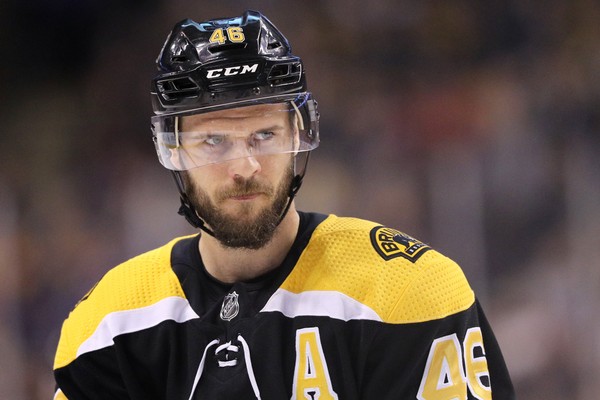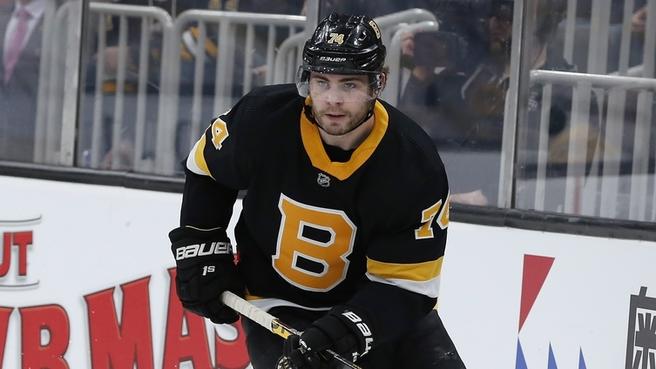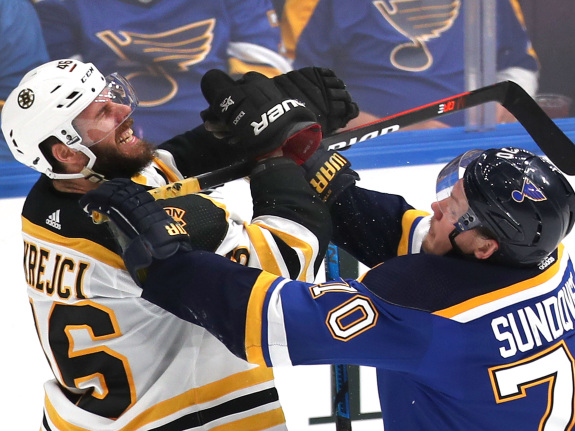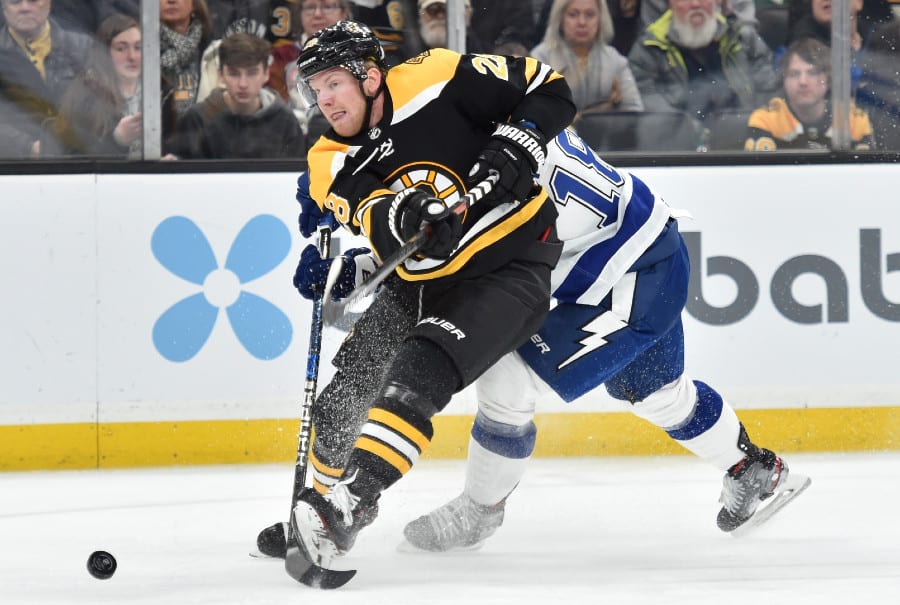
By Joe Chrzanowski | Follow Me on Twitter @jchrz19
If you are a Bruins fan, unless you have been living in a cave for the last five years, you already know that Boston’s first line, comprised of Brad Marchand, Patrice Bergeron, and David Pastrnak, is one of the finest in the NHL. You also know that since Jarome Iginla left the Bruins (after the 2014 season), they have been searching for an effective right-wing to ride shotgun with skilled center David Krejci. The B’s veteran from Sternberk, Czechoslovakia has been one of their better performers over the years, particularly in the playoffs, even when he has been paired with less than stellar talent. When he has been given legitimate Top Six linemates to work with, he generally takes his game to an even higher level.
In last year’s postseason, the Bruins came up just short, losing to the Blues in the seventh game of the Stanley Cup Finals. As is usually the case, people looked for reasons why the team was not able to finish their quest and return the Cup to Boston. The team allowed only 2.13 goals against per game over 24 games, best in the playoffs. So, generally speaking, the defense and goaltending were not an issue that cost them the championship. On the flip side, their 3.29 goals scored per game was second to only the Golden Knights, so that would not appear to be a problem either.

However, when you break it down a little further and look at just the Finals, you can see a huge disparity in points scored between the lines and also on the power play versus even strength. The Bruins scored 22 goals in the series, 14 were at even strength, seven with the man advantage, and one short-handed. So, nearly a third of the team’s goals were scored on the power play. Of the 14 tallies at even strength, only two were scored by the first line (one by Marchand, one by Pasta), and only two by the second line (one by DeBrusk, one by Kuhlman). The vast majority of the damage was done by the Bottom 6, despite getting less time on the ice than their teammates from the first two lines.
Two of the B’s biggest clutch performers, Patrice Bergeron and David Krejci were held scoreless at even strength, with Bergeron accounting for one tally on the man advantage. I don’t care what team you are when that happens in a series, it doesn’t bode well for your success. Clearly, the Bruins Bottom 6 was performing as well or better than the Blues third and fourth lines, but their top two lines were subpar. What does this mean? Was St. Louis more talented? Were their top two lines deeper than Boston’s?

In my opinion, it was simply because Boston was too reliant on their first line for the vast majority of the year, and did not give David Krejci and the second line enough firepower to compete against the top teams. Against lesser teams, the Bruins were able to get away with it. The first line was able to overwhelm teams, even though they knew what was coming. However, when you are in the playoffs versus the upper echelon teams from the East, and ultimately playing the best team from the West, Karson Kuhlman or David Backes on Krejci’s wing is just not going to cut it. This situation gets exacerbated when the wing on the other side, Jake DeBrusk, is not as consistent as you would like.
In a perfect world, my solution to this dilemma would simply be to slide David Pastrnak down to the second line with Krejci and DeBrusk to balance things out. However, Bruce Cassidy and the coaching staff appear unwilling to do this for whatever reason. Given this fact, the team needed someone talented enough to step up and fill that role going forward. During the 2019-20 regular season, it was the same old story, with a variety of wingers playing on Krejci’s right (along with DeBrusk on the other side). The first line accounted for 238 points (148 at even strength), and once again dominated teams night in and night out.
Obviously, last year’s playoffs were on GM Don Sweeney’s mind as the team approached the trade deadline. He acquired 24-year-old Czech winger Ondrej Kase from the Anaheim, ostensibly to fill that hole on Krejci’s right side. Kase is a skilled player who showed flashes with the Ducks but has seen his development hampered by a wide variety of injuries. His start with the B’s was no different and it would be nearly three weeks after he was traded before he would get into the lineup due to an “upper-body injury”. He played only six games for Boston before the season was stopped, registering only one assist.
When the season resumed, Kase was practicing, but was declared “unfit to play”. He did not take the ice for game action until the last round-robin game versus the Capitals. He did record an assist but had no shots on goal. At this point, it seemed that the Bruins might be facing the same problem they did a year ago, with teams being able to load up on them in an attempt to stop the first line. Fortunately, I am happy to report that even though it has been a very small sample size, it appears that the second line may be better prepared to contribute than they did last year, particularly in the Finals.
Through three games, the line has performed exceptionally well, and with David Pastrnak injuring himself in Game One, they have picked up the slack for the first line. The line has had modest production thus far in the series, with Krejci registering five points (one goal/one assist at even strength), Kase one assist, and DeBrusk nothing. However, in this case, the stat line is not painting an accurate picture of how the line has performed.
Through four games together (one round-robin, three playoffs), the trio has recorded 33 shots on goal (11 for each), which ties them with the first line. At even strength, they have out-chanced their opponents 50 to 34 (59.52%) and out-shot them 25 to 15 (62.50%). This also does not take into account the sheer volume of quality scoring chances they have had, but been unable to convert. In Game One alone, DeBrusk missed two open nets and hit the post on another great opportunity. Even more impressively, they have been playing well without Pastrnak in the lineup. When he returns (hopefully for Game Four), this should make it even more difficult for Carolina to defend the second line.

As I mentioned earlier, it has only been three games so far, so it is probably too early to definitively say that the second line has arrived as impact performers. However, they have looked good against a very talented Carolina team, and given Bruins fans more hope than last year for a balanced Top Six. Given how well the second line has played, for today’s game Boston are -130 favorites to win. This should bode well for them as the team attempts to advance in the playoffs.
(Thanks to Natural Stat Trick and NHL.com for the statistics)
Check out the new Black N’ Gold Hockey Podcast episode 190 that we recorded below! You can find our show on many worldwide platforms such as Apple Podcasts, Google Podcasts, iHeart Radio, Spotify, SoundCloud, and Stitcher.
[soundcloud url=”https://api.soundcloud.com/tracks/876999151″ params=”color=#ff5500&auto_play=false&hide_related=false&show_comments=true&show_user=true&show_reposts=false&show_teaser=true&visual=true” width=”100%” height=”450″ iframe=”true” /]Please subscribe to our new Black N’ Gold Hockey YouTube channel! We’d really appreciate the continued support. Click HERE for exciting Black N’ Gold online content!!


0 Comments
1 Pingback